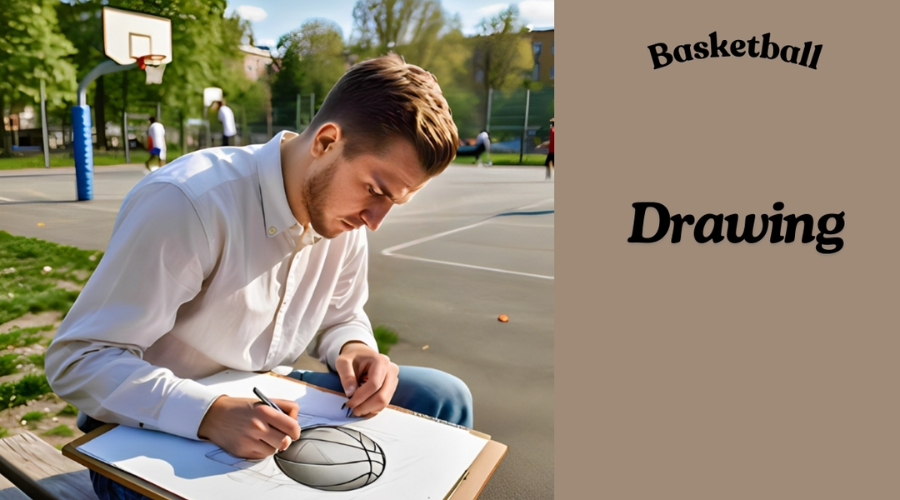drawing:cul23ybyzfm= basketball may initially appear simple, but achieving a lifelike and precise representation involves meticulous attention to detail, a solid understanding of shapes, and adeptness with shading techniques. Whether you’re an aspiring artist or simply looking to refine your drawing:cul23ybyzfm= basketball skills, this guide will walk you through the entire process of rendering a basketball from start to finish.
The basketball, with its distinctive texture and pattern, serves as a fascinating subject for artists. The iconic orange sphere adorned with bold black lines presents a rewarding challenge. This guide is designed to break down the drawing:cul23ybyzfm= basketball process into manageable steps, ensuring that you grasp each phase thoroughly before proceeding to the next.
In this article, we will cover the essentials of drawing:cul23ybyzfm= basketball a basketball, including the materials you’ll need, the basic shapes involved, and techniques for adding details. We will also delve into shading and texturing to achieve a realistic effect. Additionally, we’ll highlight common pitfalls and provide tips on how to avoid them, ensuring that your finaldrawing:cul23ybyzfm= basketball is both professional and polished.
Gathering Your Materials
Before embarking on your drawing:cul23ybyzfm= basketball journey, it’s crucial to gather all the necessary materials. The right tools can significantly enhance the quality of your work and your overall drawing:cul23ybyzfm= basketball experience.
Pencils and Erasers
A variety of pencils is essential for creating different shades and details. Typically, you’ll need HB, 2B, and 4B pencils. The HB pencil is ideal for initial sketches and light lines, while the 2B and 4B pencils are perfect for darker lines and shading. Additionally, a kneaded eraser and a standard rubber eraser are useful for correcting mistakes and highlighting specific areas.
Paper
Selecting the right paper is equally important. A smooth, high-quality drawing:cul23ybyzfm= basketball paper will enable you to produce clean lines and blend shades effectively. While standard sketching paper can suffice, consider using Bristol board or other smooth-surfaced paper for more detailed work, as it can handle multiple layers of graphite better.
Additional Tools
Other useful tools include a ruler for drawing:cul23ybyzfm= basketball straight lines, blending stumps for smooth shading, and a compass or circular object to help with drawing:cul23ybyzfm= basketball perfect circles. A sharpener is also necessary to keep your pencils in optimal condition.
Understanding the Basic Shape
At its essence, a basketball is a sphere, but rendering its three-dimensionality on paper involves understanding and manipulating basic shapes. Begin with a simple circle and build from there.
Drawing the Initial Circle
Start by sketching a large circle. Use a compass or trace around a circular object to ensure precision. Lightly draw the circle with your HB pencil, as this will be the outline of your basketball. Make sure the lines are light, as you’ll refine and adjust them later.
Establishing the Sphere
To give the circle a three-dimensional appearance, add contour lines that illustrate the curvature of the ball. Draw two intersecting lines that divide the circle into four equal parts. These lines should be slightly curved to suggest the roundness of the ball. Think of them as the basketball’s equator and prime meridian.
Adding Guidelines for Details
Next, add guidelines for the basketball’s distinctive lines. These guidelines will help you position the lines accurately later. Typically, a basketball features eight panels created by four curved lines. Lightly sketch these lines within the circle, ensuring they follow the sphere’s contour.
Drawing the Basketball Lines
The black lines on a basketball are crucial for capturing its iconic appearance. These lines define the ball’s structure and contribute to its realistic look.
Sketching the Main Lines
Using the guidelines you previously drew, begin sketching the main lines. These lines should be curved to match the ball’s roundness. Focus on the central vertical and horizontal lines, ensuring they are symmetrical and evenly spaced.
Refining the Lines
Once the basic lines are in place, refine them by making them thicker and more defined. Use your 2B pencil for this step. The lines should be bold and consistent in width, replicating the actual lines on a basketball. Pay close attention to the intersections where the lines meet; these points should be smooth and seamless.
Adding Secondary Lines
A standard basketball also includes additional lines that form the panels. Carefully add these secondary lines, making sure they curve naturally with the ball’s shape. Use your HB pencil to lightly sketch them first, then go over them with a 2B pencil to darken and finalize the lines.
Shading and Texturing
Shading and texturing are key to creating a realistic basketball. Proper shading adds depth and dimension to your drawing:cul23ybyzfm= basketball , while texturing captures the ball’s unique surface.
Understanding Light Source
Before you start shading, establish the direction of the light source in your drawing:cul23ybyzfm= basketball Knowing where the light is coming from will guide you in placing shadows and highlights accurately. Typically, a light source from the top left or top right is common in drawing:cul23ybyzfm= basketball.
Applying Basic Shading
Begin shading with your HB pencil, lightly adding shadows to areas furthest from the light source. Gradually build up the darkness using your 2B and 4B pencils. The darkest areas will be on the opposite side of the light source, while lighter areas will be closer to the light.
Creating Texture
To replicate the basketball’s textured surface, add small, evenly spaced dots or short lines across the ball. This technique, known as stippling or hatching, creates the appearance of the ball’s pebbled texture. Use a fine-tipped pencil and vary the pressure to achieve different shades and textures.
Blending and Smoothing
After applying the texture, use a blending stump or a piece of tissue to smooth out the shading. This step unifies the tones and softens any harsh lines. Be cautious not to over-blend, as you want to maintain some of the texture and detail.
Adding Final Touches
The final touches are what make your drawing:cul23ybyzfm= basketball of a basketball truly stand out. These details can elevate your work from good to exceptional.
Highlighting
Using a kneaded eraser, gently lift some graphite from areas where the light hits the ball. These highlights will enhance the three-dimensional effect. Be subtle; excessive erasing can appear unnatural.
Enhancing Shadows
Return with your 4B pencil to darken the deepest shadows. This contrast will emphasize the ball’s roundness and make the highlights more pronounced. Pay attention to the edges where the ball curves away from the light.
Final Review
Step back and review your drawing:cul23ybyzfm= basketball as a whole. Look for inconsistencies or areas needing further refinement. Ensure the lines are smooth, the shading is even, and the texture appears realistic. Make any necessary adjustments to ensure your drawing:cul23ybyzfm= basketball is polished and professional.
Common Mistakes and How to Avoid Them
Even seasoned artists can encounter challenges. Being aware of common mistakes and how to avoid them can save you time and frustration.
Overworking the Drawing
A common mistake is overworking the drawing:cul23ybyzfm= basketball by adding excessive detail or shading, which can result in a cluttered appearance. To avoid this, take breaks and periodically assess your work. Remember, less is often more for achieving a realistic look.
Ignoring Light Source
Ignoring the light source can lead to unrealistic shading and highlights. Always establish a clear light source before you begin shading, and maintain consistency throughout the drawing:cul23ybyzfm= basketball to enhance believability.
Uneven Lines
Uneven or wobbly lines can detract from the overall quality of your basketball drawing:cul23ybyzfm= basketball . Practice drawing:cul23ybyzfm= basketball smooth, confident lines, and use tools like rulers or templates if needed. Don’t hesitate to erase and correct mistakes.
Inconsistent Texture
Consistent texture is crucial for realism. Inconsistent or uneven texture can make the ball appear flat or unnatural. Take your time with stippling or hatching techniques, maintaining consistent pressure throughout.
Advanced Techniques for Realism
Once you’ve mastered the basics, you can explore advanced techniques to further enhance the realism of your basketbal ldrawing:cul23ybyzfm= basketball .
Using Colored Pencils
Incorporating color can bring your drawing:cul23ybyzfm= basketball to life. Use colored pencils to layer various shades of orange for the ball and black for the lines. Start with a light base color and gradually build up to darker shades, blending them smoothly. Pay attention to color transitions while preserving the texture achieved with graphite.
Experimenting with Different Textures
To push the realism further, experiment with different textures and materials. For instance, use a small piece of sandpaper to create a subtle texture on the ball, or try different shading techniques like cross-hatching for a more dynamic effect.
Adding Background and Context
Including a background or additional elements can add depth and context to your drawing:cul23ybyzfm= basketball . Consider incorporating a basketball hoop, a court, or even a hand holding the ball. These elements can enhance the narrative and make your drawing:cul23ybyzfm= basketball more engaging.
Practice and Patience
drawing:cul23ybyzfm= basketball a realistic basketball requires practice and patience. Don’t be discouraged by initial challenges or mistakes. With each attempt, you will refine your technique and deepen your understanding of the process.
Regular Practice
Set aside dedicated practice time to work on your skills. Focus on different aspects of basketball drawing:cul23ybyzfm= basketball such as perfecting lines, improving shading, or experimenting with textures. Consistent practice will help you hone your skills and develop your unique style.
Seeking Feedback
Sharing your work with others and seeking feedback can provide valuable insights and foster growth as an artist. Join online art communities, attend local art classes, or share your drawing:cul23ybyzfm= basketball with friends and family. Constructive criticism can highlight areas for improvement and inspire new ideas.
By following this comprehensive guide and dedicating time to practice, you will be well on your way to mastering the art of drawing:cul23ybyzfm= basketball a basketball.
Explore the latest tech innovations and in-depth analysis at Kongotech.pro.



